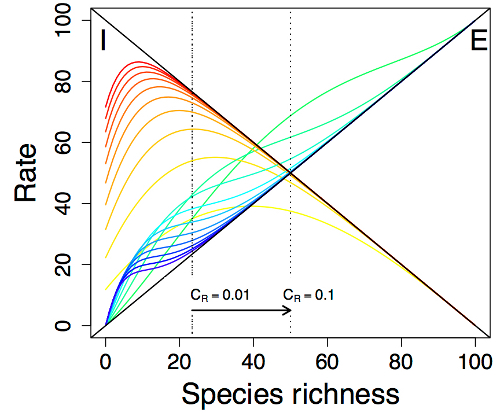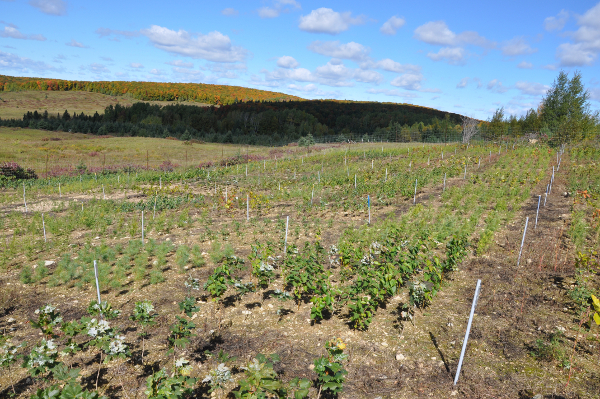
We are studying mechanisms promoting the emergence and maintenance of diversity in metacommunities and metaecosystems. A metacommunity is as a set of local communities connected together by dispersal. The logical extension of this concept is the metaecosystem, a set of local ecosystems connected by exchanges of organisms and materials (e.g. energy or nutrients). Metaecosystems form the most complex ecological systems, as they incorporate trophic structure, spatial dynamics and biogeochemical cycles.

Figure: The trophic theory of island biogeography (Gravel et al. 2011, Ecology Letters). Adding a trophic constraint on species immigration and extinction affects the equilibrium species richness in a local community. Reciprocally, insular dynamics affect the local structure of communities sampled from the regional species pool.
The network approach has been useful for understanding various phenomena from a range of disciplines, such as propagation of infectious diseases, the exchange of information between scientists, or the resistance of the internet network to attacks on servers. Ecological networks are highly organized structures, far from random, and their self-organized properties provide them with stability and resistance to disturbances. We are currently conducting theoretical and empirical studies to better understand the spatial structure of ecological networks and their dynamics. We also develop tools to quantify their spatial variability. We hypothesize that despite considerable turnover in species composition over space, ecological forces are acting to keep network structure constant and maintain ecosystem functioning.
Figure: Biodiversity-ecosystem functioning experiment with forest trees at Auclair, Témiscouata. The plantation of 12 000 trees was established in June 2010. We manipulated simultaneously the taxonomic, functional and phylogenetic diversity with an innovative design combining 6 native tree species and their exotic (European) functional equivalents.
In a world increasingly disturbed by human activities, it is now urgent to evaluate the potential role of biodiversity on shaping ecosystems properties and services. The relationship between biodiversity and ecosystem functioning has been the subject of considerable interest and controversy during the last decade. This area of research has now reached a maturing state, as general syntheses emerges. Nonetheless, our understanding of the functioning of complex (and realistic) communities, such as diverse food webs, is still at its infancy. If we have a good understanding of the impact of a carnivore and of an herbivore on the primary productivity in a simple linear food chain, it is much more difficult to predict the impact of species lost in a reticulated network of interactions with omnivory, intra-guild predation, loops and cannibalism. We study the impact of species addition and extinction in complex ecosystems with simulation models and experimental systems. Our objectives are to understand i) the role of the assembly history and ii) indirect interactions on ecosystem functioning, and iii) find synthetic descriptors that will help predict the impact of species lost on the functioning of complex communities.


Figure: We use the microbial food web found in the leaves of the purple pitcher plant (Sarracania purpurea) to experimentally test the impact of community structure and environmental constraints on ecosystem functioning. The functioning of this food web is essential for the mutualistic relationship with the plant, found from Florida up to northern Quebec. We have observed that the highly conserved functional structure of its microbial food web contributes to maintain functioning despite a strong temperature gradient along the geographic range of the plant.
The bulk of studies on global change and biodiversity have relied on biogeography and focused on range shifts, while very little is known about future community assembly dynamics. Because the population responses of many species to global changes is unlikely to be simply additive, ecologists need to integrate these spatial and ecosystem-level approaches of biodiversity. The current challenge is to understand how communities will re-assemble following individual species responses and how these emergent ecosystems will function. The long-term objective of our research program is to integrate the disciplines of biogeography and biodiversity-ecosystem functioning into a coherent theoretical framework. We hope it will help to better understand the impacts of global change on the provision of ecosystem services. We tackle this objective with a mix of approaches, combining mathematical models and experimental manipulations of the pitcher plant microbial food web.